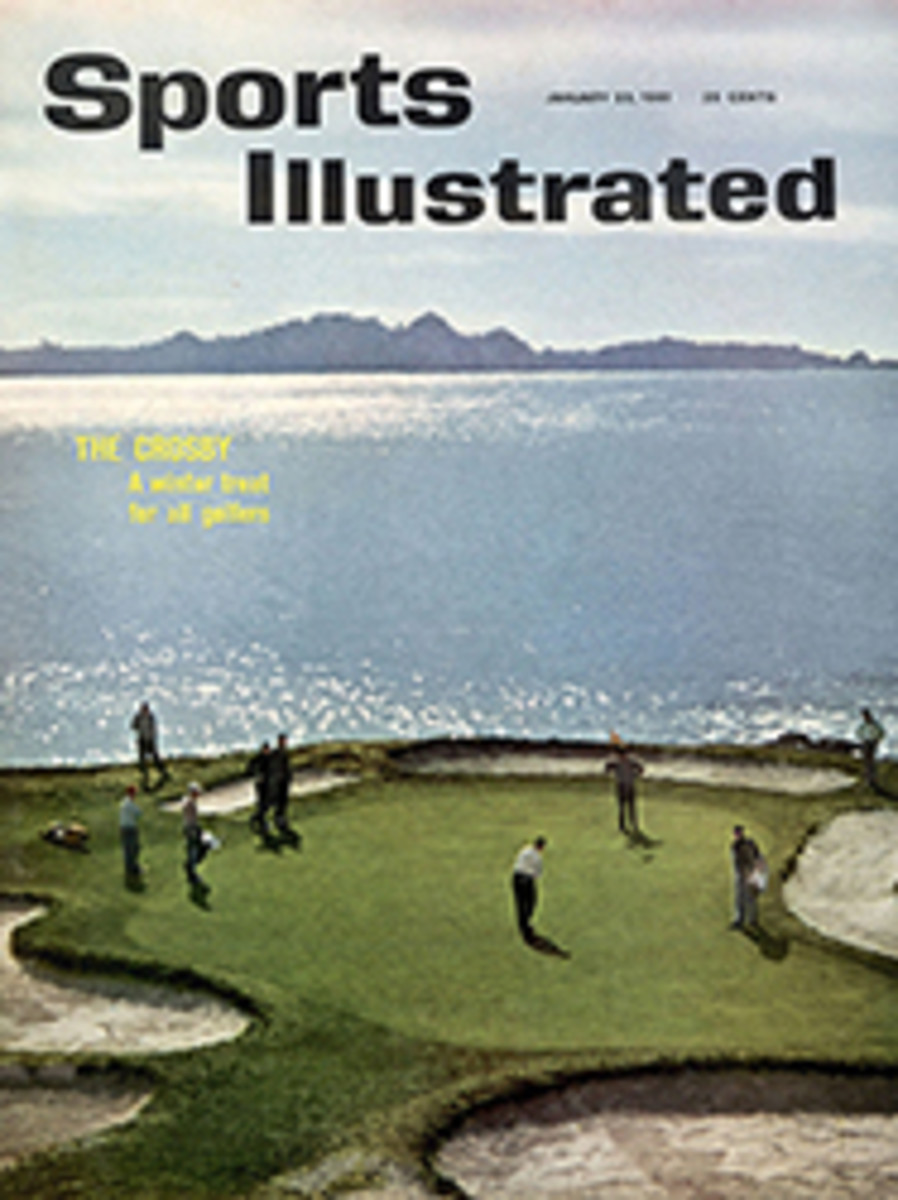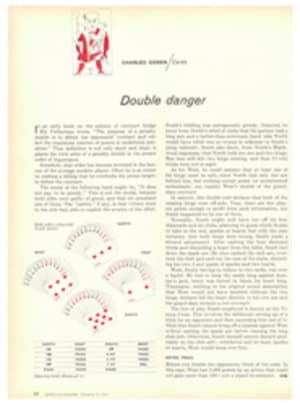
High tides at the boat show
As the 51st National Motor Boat Show opened last week, the view from the second-floor balcony of the New York Coliseum suggested the world's busiest marina at the lowest of low tides. A 47-foot diesel yacht complete with air conditioning and soft Muzak rubbed topsides with sport fishermen, midget ocean racers, runabouts, cabin cruisers, day sailers and prams. Throughout the day, and on close to midnight when the last tired exhibitor drifted out through the empty lobby, more than 40,000 potential skippers milled through the glittering displays to get a look at what was new in yachting.
One of the first things they noticed was that 49% of the show fleet was constructed of fiber glass (SI, Nov. 28, 1960). The largest plastic hull was Pearson's 37-foot sport fisherman. Nearby was the first glass production copy of Moppie, the Bertram Boat Company's winner of last year's Miami-Nassau Ocean Powerboat Race. Penguin dinghies, Thistle planing sloops, and Cougar and Tiger Cats were shown in fiber glass for the first time. And there was a fascinating fleet of midget fiber-glass ocean racers, amazing demonstrations of the naval architect's ability to squeeze a gallon of accommodations into a pint of hull. On a length of 25 feet or less, bunks to sleep four were provided, together with refrigeration and cooking facilities and a head.
The glass designers are not the only ones coming in with new techniques and materials to challenge the builders of wood boats. Richardson showed a 40-foot cabin cruiser of planked aluminum, a process developed with Avro Aircraft of Canada. Preshaped strakes are fastened to frames with stainless steel screws; a synthetic-rubber seam seal is used instead of calking. Viewed from a distance of only a few feet, the hull looks like wood. The other new construction concept is U.S. Rubber's five-ply Royalite, a blend of plastic and synthetic rubber. An outer skin provides color and resistance to weathering and abrasions, while a cellular core imparts buoyancy, stiffness and shock-absorbing qualities.
To one who has always believed that a boat should not only behave like a boat but also look like one, it was particularly good to see outboard cruisers and runabouts that seemed actually designed for the water and not for the boulevards. With a few notable exceptions, upswept tail fins, automobile headlights and futuristic creations of plastic and chrome are being replaced by more practical designs. At the same time, the engine manufacturers have slowed their race for greater and greater horsepower, a race which threatened to create unwieldy monsters defeating the original purpose of the outboard. Only one company, West Bend, made a sizable horsepower jump—from 40 hp all the way to join Mercury at the top with 80.
Evinrude and Johnson are both staying at 75. And instead of size, these companies are emphasizing improved engineering, plus a few fringe benefits including, praise be, quietness. Scott has joined Evinrude and Johnson in the 75-hp class, and is offering a boat of its own, a 17-foot fiber-glass runabout, to go with the engine. This is the first time an outboard maker has moved into the boat-building business. The effect on the other engine manufacturers, not to mention the boat dealers, will be worth watching.
But perhaps the most interesting new outboard was the 30-horsepower Bundy 500. Built by Innocenti of Milan, manufacturer of the Lambretta motor scooter, the Bundy is the first foreign outboard with a real chance to cut into the virtual monopoly held by U.S. engines. A handsome, compact package, the Bundy weighs only 103 pounds. It is efficient for slow-speed trolling, but it also has speed and durability. It won its class in the recent Orange Bowl nine-hour endurance race in Miami.
This new outboard, a subsidiary product of the big Bundy Tubing Company, represents part of another trend—the arrival in the field of large corporations anxious to diversify their holdings by acquisitions in the boating field. In fact, the situation is not unlike that in Detroit during the past decades when purchases, consolidations and mergers resulted in the survival of only a few giants. Within the last year, Larson, Owens and Cutter boats all were acquired by the Brunswick Corporation, better known for bowling alleys and billiard tables. Crestliner was purchased by the Bigelow-Sanford carpet firm. Chris-Craft went to NAFI (short for National Automotive Fabrications). Grumman Aircraft Corporation's Boat Division has merged with Pearson of Bristol, R.I., and Pearson in turn has swallowed Aeromarine Plastics of Sausalito, Calif., manufacturer of the Bounty class. As a result of these operations, the smaller dealers and builders are bracing themselves against the impact of mass-production techniques and high-powered sales campaigns inaugurated by corporations accustomed to dealing in huge volume.
An innovation of only recent standing, the so-called inboard-outboard drive units (SI, April 25, 1960) proved to have made considerable headway in the power field. These flexible units are attached to the transom but are powered via hull-through connections by inboard engines. This arrangement eliminates the expensive and highly vulnerable shaft, strut and rudder necessary for the inboard; and it also does away with the difficulties of moving and caring for the large outboards. At the Boat Show only two years ago the Volvo-Penta Aquamatic was the sole inboard-outboard on display. Now Muncie Gear Works is producing Flexidrive, Eaton the Powernaut drive, and Western Gear the Seapower outdrive. Engine manufacturers are redesigning to accommodate these new drive systems; and at the Coliseum last week over 30 runabouts and utility models featured inboard-outboard packages.
However, the most radical step in boat propulsion was made by Boeing Aircraft Company with its introduction of a 260-hp. jet turbine. This engine, currently designed to turn a shaft and propeller, is nevertheless a true jet which, if altered slightly, could generate power by thrust alone. Weighing only 625 pounds, it starts instantaneously and can go to full throttle without warmup. It is free of vibration, will not stall and burns almost any sort of fuel—diesel, kerosene, white gas and, in an emergency, leaded gas. Yet for the moment, the Boeing turbine seems to have rather limited application because of both the price tag ($15,000) and the fuel consumption (37 gallons of gas per hour at top speed). Still, some boat buyers will undoubtedly pay the price to enjoy such advanced engineering, and further research at Boeing may cut both original and operating costs.
Among the boating accessories, the trends were less noticeable. Thanks to transistors, electronic aids to navigation have been made more powerful and less bulky. Radiotelephones, direction finders, and depth finders have been scaled down in size and cost, though Loran and Radar still remain out of reach for any but the larger and more luxurious vessels. The only real breakthrough in equipment seemed to be the depth/distance finder by ERA Dynamics Corporation. This device not only can measure depths under the keel down to 300 feet and detect obstacles the same distance dead ahead, but one model also reads at a 45° angle under the bow to a distance of 215 feet, thus informing the skipper of a rising bottom.
In the smooth waters of the Coliseum it is easy to forget that the sea can be uncomfortable and dangerous. Three concessions to weather and human frailty reminded one of these realities. Most important was Guest Co.'s electronic distress flare capable of providing flashes of 125,000 candle-power. This device saved the life of John Weston, a crewman aboard Scylla when he was washed overboard in the last Bermuda Race.
For the ladies, Sperry developed a wraparound skirt of orange neoprene to wear below waterproof jackets of the same material, thus eliminating the necessity of struggling into oilskin trousers in foul weather. And last of all, there was Alcort, which introduced its Scuttlebutt shorts for men, featuring a large circular patch of foam rubber on the seat, covered by nonskid chamois. Welcome to new comfort, men!
PHOTO
ITALIAN-MADE BUNDY 500 MAY CRACK U.S. MONOPOLY IN HIGH-SPEED OUTBOARDS
PHOTO
40-FOOT RICHARDSON CRUISER HAS STRIP-PLANKED ALUMINUM HULL, COSTS $34,340

